Pass O'Level: Biology paper one questions
Home schooling material from Vision Group for O'Level biology students.
Which type of soil erosion results in formation deep and wide water channels due to continuous flow of water on a bare surface?
A. Splash erosion.
B. Water erosion.
C. Gully erosion.
D. Reel erosion.
2. The figure below shows a strip of a commenlina plant stem after being placed in a solution for 20 minutes.

In which of the following solutions was the striped placed?
A. Hypotonic solution.
B. Isotonic solution.
C. Hypertonic solution.
D. Strong solution.
3. The type of joint found in between femur and tibia and fibula is;
A. hinge joint
B. ball and socket joint
C. pivot joint
D. suture joint
4. A man married a woman of blood group O and all their offspring were of blood group A? Which of the following is the blood group of the man? Blood group;
A. O
B. AB
C. B
D. A
5. Which of the following explains mimicry as an adaptation of prey to prevent being eaten?
A. Change body colour to that the environment.
B. Being swift and fast.
C. Change body appearance to a form not edible by the predator.
D. Have strong sense of smell and sight.
6. The existence of separate male and female flowers on different branches of a plant promotes;
A. insect pollination
B. wind pollination
C. cross pollination
D. self-pollination
7. The figure below shows changes in weight of an organism with time.
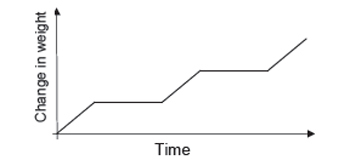
Which of the organisms below shows the growth pattern shown above?
A. Man.
B. Fish
C. Insect.
D. Bird.
8. Which of the following is the functional junction betweenneurons?
A. Dendron.
B. Synapse.
C. Dendrite.
D. Synaptic knob.
9. Which of the following results in increase of pressure at the glomerulus in the kidney?
A. Pressure generated by pumping of the heart.
B. More blood is brought to the glomerulus than taken away.
C. Efferent vessel is wider than Afferent vessel.
D. Too many small sized components in blood.
10. Presence of alveoli in the mammalian lung;
A. reduces diffusion distance of respiratory gases
B. maintains a high concentration gradient of oxygen
C. increases surface area for diffusion of large amounts of gases
D. ensures dissolution of respiratory gases for faster diffusion
11. In which of the following parts of the mammalian alimentary canal does chemical digestion of lipids occur?
A. Duodenum.
B. Ileum.
C. Stomach
D. Mouth.
12. Which of the following processes does not occur in plants?
A. Nutrition.
B. Sensitivity.
C. Locomotion.
D. Gaseous exchange.
13. The root system that has a main root that developed from the radicle with numerous smaller roots ranching from is;
A. fibrous root system
B. adventitious roots
C. clasping roots
D. tap root system
14. The figure below shows results of an experimental set up to investigate water retention capacity of different soil samples.
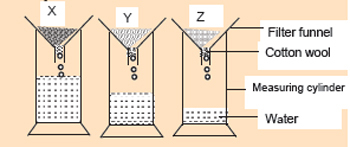
Which of the following is the correct arrangement of the soil samples from the type with the highest water retention capacity
A. X, Y and Z.
B. Y, X and Z.
C. Z, Y and X.
D. Z, X and Y.
15. The table below shows results obtained by a student after carrying out the following food test on a food sample.

Which food nutrients were present in the food sample?
A. Starch and reducing sugars only.
B. Lipids, non-reducing sugars and starch.
C. Reducing sugars, starch and proteins.
D. Proteins, non-reducing and starch.
16. Hairs on the leaf lamina reduce the rate of transpiration by trapping....
A. a layer of air
B. water inside the leaves
C. a layer of moisture around the leaf
D. dry wind around the leaf
17. Which of the following products of anaerobic respiration can be further broken down to produce energy when oxygen is available?
A. Alcohol.
B. Carbon dioxide.
C. Lactic acid.
D. Water.
18. Which of the following regulates the size of the pupil?
A. Lens.
B. Iris.
C. Ciliary body.
D. Cornea.
19. Which structure separates the heart into left and right sides?
A. Atrioventricular valves.
B. Semilunar valves.
C. Coronary vessel.
D. Vertical septum.
20. The figure below shows the effect of changes in concentration of auxins on the rate of stimulation and inhibition of growth in roots and shoots.
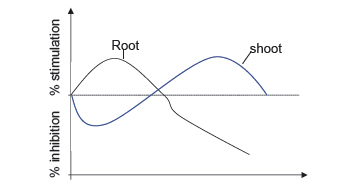
Which of the following is a correct figure?
A. Low concentration of auxins stimulate growth in shoots.
B. High concentration of auxins stimulate growth in roots.
C. High concentration of auxins stimulate growth in shoots.
D. Low concentration of auxins inhibit growth in roots.
21. Which group of organisms below are autotrophs?
A. Consumers
B. Producers.
C. Decomposers.
D. Herbivores.
22. Which of the following provides evidence for evolution?
A. Special creation theory.
B. Big bang theory.
C. Mutation.
D. Paleontology.
23. Which of the following are formed in the ovary immediately after occurrence of ovulation?
A. Corpus luteum.
B. Zygote.
C. Embryo.
D. Graafi an follicle.
24. Within the zone of cell division in the shoot apical meristems...
A. divide by meiosis
B. increase in size
C. become specialised
D. divide by mitosis
25. Which of the following structures is used by the bony fish to regulate its depth during locomotion?
A. Caudal fin.
b. Lateral line.
C. Swim bladder
D. Paired fins
26. Which of the following processes does not involve excretion?
A. Egestion.
B. Exhalation.
C. Sweating.
D Urination.
27. A mammalian tooth consists of three curved roots and a broad crown with cusps and ridges. Which type of tooth match the descriptions?
A. Molar tooth.
B. Canine tooth.
C. Premolar tooth.
D. Incisor tooth.
28. Which of the following correctly distinguishes lymphatic system from circulatory system?
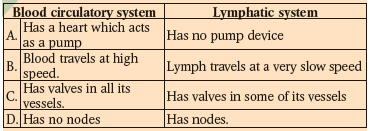
29.The hormone that increases the rate of heart beat
A. adrenalin
B. prolactin
C. glucagon
D. antidiuretic hormone
30. The component of blood absent in glomerular filtrate and urine is;
A. glucose
B. mineral salts
C. proteins
D. urea
SECTION B
31. A graph of variation in the rate of metabolism of mammals A and B with environmental temperature
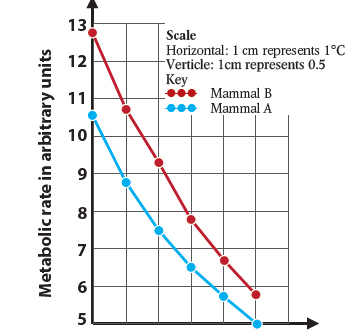
a) Giving a reason, suggest which mammal is bigger in size than the other.
b) Describe the rate of metabolism of mammal B.
c) Suggest a
i) similarity between the rate of metabolism in the mammals
ii) difference between rate of metabolism in the mammals
d) Explain the;
i) effect of increasing temperature on the rate of metabolism
ii) difference suggested in c(ii) above
e) Suggest some of the responses of the mammals to the increase in environmental temperature.
f) Suggest how ectotherm responds to increase in environmental temperature.
a) Explain the following observations
i) clay soil has high water retention capacity
ii) sand soil has low capillarity
b) The experimental setup below was set to investigate the
presence of microorganisms in a soil sample.

c) Suggest the observation that was made in each setup.
d) Explain the observations suggested above.
e) Suggest the roles of microorganisms in the soil.
33. Study the different sections of fruity below.
a) Identify the type of section shown in Q and S.
b) With a reason state the type of succulent fruit represented by P and Q.
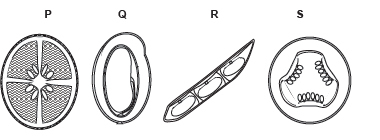
c) Describe the placentation in Q and S.
d) State the differences between P and R.
SECTION C
34. a) State the antigens and antibodies found in each type of blood group in humans.
b) Suggest explanations for individuals of blood group;
i) O being universal donors
ii) AB being universal recipients
c) Describe the various ways individuals gain immunity against various infections.
35. a) Explain the need for each requirement or condition in germination.
b) Describe an experiment to investigate the conditions necessary for germination.
36. a) State the various prevention methods of sexually transmitted infections.
b) Discuss the various methods of birth control used in Uganda.
37. a) What is meant by parasitism.
b) State the;
i) main challenges faced by parasites
ii) adaptations of parasites to their mode of life.
7
a) Giving a reason, suggest when mammal is bigger in size than the other.
b) Describe the rate of metabolism of mammal B.
c) Suggest a
i. similarity between